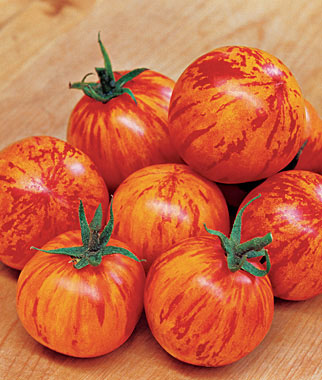- Home
- Garden Thyme Blog
- Themes
- Flowers
-
Veggies
-
Warm Season Vegetables
>
- About Beans >
- About Corn >
- Cucumbers >
- Melons
- Peppers >
- Squash >
-
Tomatoes
>
- How to Harden Off Tomato Plants
- How (and when) to Prune Tomatoes
- Magnesium Sulfate (Epsom Salt) for Tomatoes
- Blossom End Rot in Tomatoes
- Growing Cherry Tomatoes in Hanging Baskets
- 4 Best Tomatoes for Short Seasons - Early Tomatoes
- 5 Early Maturing Tomatoes for Short Season Gardening
- How to Ripen Green Tomatoes
- How to Make Sun-Dried Tomatoes at Home
- How to Grow a Pomato Plant
-
Cool Season Vegetables
>
-
Warm Season Vegetables
>
- Herbs
- Gardening Basics
- Garden Pests
- Birds
- Fiddleheads and Fairies
- About Us
- Contact Us
- How to Marinate Roasted Vegetables
|
Some of you may remember my excitement this spring when I ordered my red lightning tomato seeds. I fell in-love with these fiery little tomatoes and knew I had to grow them in my garden. Here are the results:
Days to Maturity: I started the seeds sometime in late March or the first week of April and set the seedlings out in the garden around the first of June. The first tomatoes began to ripen in the middle of August. This means the it took them about 70 days to reach maturity. Not bad for tomatoes with an expected days to maturity of 82 days. Size: Burpee's plant description lists 'Red Lightning' tomatoes as 1- to 2-ounce fruit with a diameter between 2-1/2 to 3 inches. My largest 'Red Lightning' tomato measured just under 2 inches and weighed in at 2.6 ounces. I'm not sure how Burpee came up with their figures for the size and weight of these tomatoes. My 'Red Lightning' tomatoes fell considerably short of Burpee's size description, yet exceed the weight. Appearance: This is an attractive tomato that lives up to the image and description of fiery orange with red 'flames'. The stripes are evident when the tomato is green. It gradually progress from two-tone green to green and yellow-orange, and finally to orange and red (with several subtle variations in between). Growing Habits: This is an indeterminant tomato that grows to a height of 4 feet or more. The foliage resembles the sprawling vines of cherry tomatoes. If you grow red lightning tomatoes, plan to stake or cage them. Otherwise, the branches crack and break under the weight of the tomatoes.The tomatoes grow in clusters of 6 or 8, making this a showy plant. Flavor: The flavor of red lightning tomatoes is a bit of disappointment. Although they have decent flavor they do not compare with 'Early Girl' or 'Big Boy'. These tomatoes are best for salads where they add a splash of unexpected color but don't depend on rich tomato flavor. Problems: The red lightning tomato is susceptible to blossom end rot. When grown in the same beds as my other tomatoes ('Chocolate Cherry', 'Early Girl' and 'Big Boy') the 'Red Lightning' tomatoes showed signs of blossom end rot while the others did not. This suggests that red lightning tomatoes either require higher amounts of calcium or are more sensitive to moisture fluctuations than other tomatoes. I will definitely try 'Red Lightning' tomatoes again next year, but I will probably grow them in containers to maintain more control over the moisture level. Adding organic matter to the soil and mulching may also prevent problems with blossom end rot.
0 Comments
Leave a Reply. |
For more nature photography, check out my photography site.
|
Copyright © 2014 Nannette Richford
- Home
- Garden Thyme Blog
- Themes
- Flowers
-
Veggies
-
Warm Season Vegetables
>
- About Beans >
- About Corn >
- Cucumbers >
- Melons
- Peppers >
- Squash >
-
Tomatoes
>
- How to Harden Off Tomato Plants
- How (and when) to Prune Tomatoes
- Magnesium Sulfate (Epsom Salt) for Tomatoes
- Blossom End Rot in Tomatoes
- Growing Cherry Tomatoes in Hanging Baskets
- 4 Best Tomatoes for Short Seasons - Early Tomatoes
- 5 Early Maturing Tomatoes for Short Season Gardening
- How to Ripen Green Tomatoes
- How to Make Sun-Dried Tomatoes at Home
- How to Grow a Pomato Plant
-
Cool Season Vegetables
>
-
Warm Season Vegetables
>
- Herbs
- Gardening Basics
- Garden Pests
- Birds
- Fiddleheads and Fairies
- About Us
- Contact Us
- How to Marinate Roasted Vegetables
